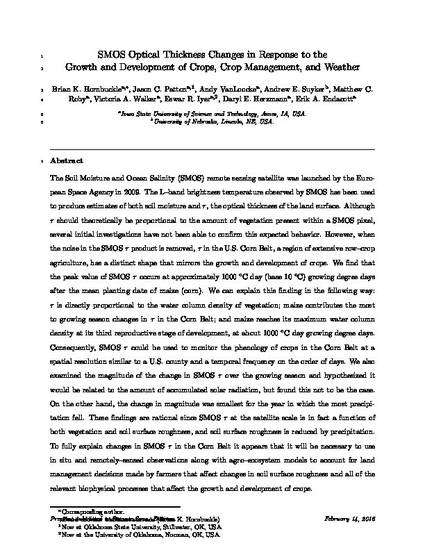
The Soil Moisture and Ocean Salinity (SMOS) remote sensing satellite was launched by the European Space Agency in 2009. The L-band brightness temperature observed by SMOS has been used to produce estimates of both soil moisture and tau, the optical thickness of the land surface. Although tau should theoretically be proportional to the amount of vegetation present within a SMOS pixel, several initial investigations have not been able to confirm this expected behavior. However, when the noise in the SMOS tau product is removed, tau in the U.S. Corn Belt, a region of extensive row-crop agriculture, has a distinct shape that mirrors the growth and development of crops. We find that the peak value of SMOS tau occurs at approximately 1000 degrees C day (base 10 degrees C) growing degree days after the mean planting date of maize (corn). We can explain this finding in the following way: tau is directly proportional to the water column density of vegetation; maize contributes the most to growing season changes in tau in the Corn Belt; and maize reaches its maximum water column density at its third reproductive stage of development, at about 1000 degrees C day growing degree days. Consequently, SMOS tau could be used to monitor the phenology of crops in the Corn Belt at a spatial resolution similar to a U.S. county and a temporal frequency on the order of days. We also examined the magnitude of the change in SMOS tau over the growing season and hypothesized it would be related to the amount of accumulated solar radiation, but found this not to be the case. On the other hand, the change in magnitude was smallest for the year in which the most precipitation fell. These findings are rational since SMOS tau at the satellite scale is in fact a function of both vegetation and soil surface roughness, and soil surface roughness is reduced by precipitation. To fully explain changes in SMOS tau in the Corn Belt it appears that it will be necessary to use in situ and remotely-sensed observations along with agro-ecosystem models to account for land management decisions made by farmers that affect changes in soil surface roughness and all of the relevant biophysical processes that affect the growth and development of crops.
Available at: http://works.bepress.com/andy_vanloocke/23/

This is a manuscript of an article from Remote Sensing of Environment 180 (2016): 320, doi: 10.1016/j.rse.2016.02.043. Posted with permission.